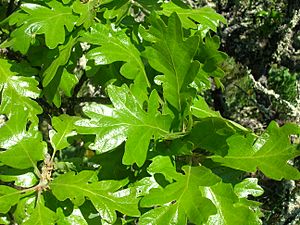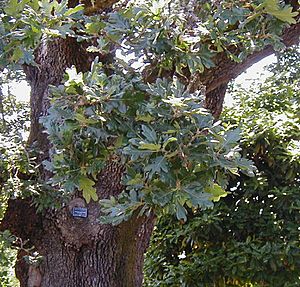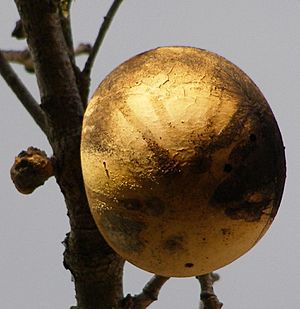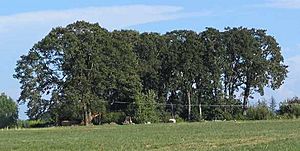Oregon white oak facts for kids
Quick facts for kids Garry oak |
|
|---|---|
 |
|
| Mature Garry oak | |
 |
|
| Conservation status | |
| Scientific classification | |
| Genus: |
Quercus
|
| Species: |
garryana
|
 |
|
| Natural range | |
| Synonyms | |
|
List
Quercus douglasii var. neaie (Liebm.) A.DC.
Quercus garryana var. jacobi (R.Br.ter) Zabel Quercus jacobi R.Br.ter Quercus neaei Liebm. Quercus patula Hansen Quercus breweri Engelm. Quercus oerstediana R.Br.ter |
|
The Quercus garryana is a type of oak tree. It lives in the Pacific Northwest region. You can find it from southern California all the way up to southwestern British Columbia.
In the United States, people often call it the Oregon white oak or Oregon oak. In Canada, it's known as the Garry oak. This tree grows near sea level in the north. Further south in California, it can be found at higher places, up to 1,800 meters (about 5,900 feet) high. The tree is named after Nicholas Garry, who was an important person in the Hudson's Bay Company a long time ago.
Contents
Where Garry Oaks Grow
In British Columbia, Garry oaks grow on the Gulf Islands. They also live on southeastern Vancouver Island. You can see them from west of Victoria up to the Campbell River area.
There are also a few small groups of these trees along the Fraser River. This is on the mainland of British Columbia. The northernmost Garry oaks are on Savary Island. The Garry oak is the only oak tree that naturally grows in British Columbia. It's also one of only two oaks native to western Canada. The other is the Bur oak.
In Washington state, these trees grow on the west side of the Cascade Range. They are common in the lowlands around Puget Sound. You can also find them on the northeastern Olympic Peninsula and Whidbey Island. They grow in the Chehalis river valley and the San Juan Islands too. Some are in the foothills of the southeastern Cascades and along the Columbia River Gorge.
In Oregon, the tree grows on the west side of the Cascade Range. It's mostly found in the Willamette Valley, Umpqua, and Rogue River valleys. It also grows along the Columbia River Gorge.
In California, one type of Garry oak, called garryana, grows in the foothills of the Siskiyou Mountains and Klamath Mountains. It's also in the Coast Ranges of Northern California. Another type, semota, grows in the Sierra Nevada mountains. It can be found as far south as Los Angeles County.
Different Types of Garry Oaks
There are three main types, or varieties, of the Garry oak:
- Quercus garryana var. garryana: This type grows into a tall tree, usually up to 20 meters (about 65 feet) high. It's found from British Columbia south along the Cascades to the California Coast Ranges.
- Quercus garryana var. breweri: This type is a smaller plant, more like a shrub. It grows up to 5 meters (about 16 feet) tall. Its leaves feel soft and velvety underneath. You can find it in the Siskiyou Mountains.
- Quercus garryana var. semota: This is also a shrub, growing up to 5 meters tall. But its leaves are not velvety underneath. It lives in the Sierra Nevada mountains.
How Garry Oaks Grow
The Oregon white oak is a tree that can handle dry weather well. It usually grows to a medium height, around 20 meters (about 65 feet). Sometimes, it can reach 30 meters (about 98 feet). It grows slowly. It can also grow as a shrub, about 3 to 5 meters (10 to 16 feet) tall.
When a Garry oak grows by itself, it has a classic oval shape like other oaks. But they can also grow close together in groups, forming a leafy roof called a canopy. Their leaves fall off in autumn, so they are deciduous. The leaves are 5–15 cm (2–6 inches) long and 2–8 cm (1–3 inches) wide. Each leaf has 3 to 7 deep rounded parts, called lobes, on each side.
The flowers of the Garry oak are called catkins. The fruit is a small acorn. It's usually 2–3 cm (about 1 inch) long and 1.5–2 cm (about 0.6–0.8 inches) wide. The acorn sits in a shallow, scaly cup. In the fall, the leaves often turn a plain brown color. Some trees might show a mix of brown, green, and yellow. A few might even have a bright "peas and corn" look.
The Oregon white oak often has a plant called mistletoe (Phoradendron leucarpum) growing on it. It also commonly hosts galls. Galls are strange bumps or growths created by tiny wasps from the Cynipidae family. The most amazing galls are "oak apples." These are green or yellow balls up to 5 cm (2 inches) big. They attach to the underside of the leaves. One common wasp that makes these galls is Cynips maculipennis. Other wasps create galls on stems and other parts of the leaves. These galls can be different shapes, like spheres, mushrooms, or even pencils.
In British Columbia, three non-native insects can bother the Garry oak. These are the jumping gall wasp (Neuroterus saltatorius), the oak leaf phylloxeran, and the gypsy moth.
There's a plant disease called Sudden Oak Death that attacks other oak trees on the Pacific Coast. However, it has not been found on the Garry oak yet. Most oaks affected by this disease are in the red oak group. The Garry oak is in the white oak group, which is usually more resistant.
Garry Oak Woodlands
The Garry oak is the only native oak in British Columbia, Washington, and northern Oregon. In these areas, Garry oak woodlands are special. They need disturbances, like fires, to keep growing. Without fires, other trees like Douglas fir would take over.
Wildfires used to be common in the drier parts of the Pacific Northwest. These fires helped the Garry oaks. But now, people stop fires from spreading. Also, early settlers and Native American tribes used to burn the land on purpose. This helped keep grasslands healthy. These grasslands provided food like camas and chocolate lily. They also offered good hunting grounds for deer and elk.
Mature Garry oaks are good at resisting fire. So, small grass fires wouldn't hurt them much. These fires stopped Douglas firs from growing. This allowed the grasslands and Garry oak woodlands to stay. Fires also kept the drier oak woodlands clear of thick bushes. Oak woodlands in wetter areas used to have more bushes, like snowberry.
Garry oak woodlands in British Columbia and Washington are very important homes for many rare plants and animals. Some of these include:
- Propertius duskywing butterfly (Erynnis propertius), which only eats oak leaves when it's a caterpillar.
- Bucculatrix zophopasta leaf-mining moth, which also only eats oak leaves.
- Lewis woodpecker (Melanerpes lewis)
- Slender billed nuthatch (Sitta carolinensis aculeata)
- Sharp tailed snake (Contia tenuis)
- Western gray squirrel (Sciurus griseus)
- Western tanager (Piranga ludoviciana)
- Western wood peewee (Contopus sordidulus)
- Western bluebird (Sialia mexicana)
- Sessile trillium (Trillium parviflorum)
- Banded cord-moss (Entosthodon fascicularis)
- Apple moss (Bartramia stricta)
- (liverwort) Riccia ciliata
- Golden Paintbrush (Castilleja levisecta)
Garry oak woodlands create a mix of different habitats. You can find grasslands, savannas (scattered trees), woodlands, and dense forests. This variety allows many more species to live there than in just one type of forest. Parks Canada says that Garry oak woodlands support more kinds of plants than any other land ecosystem in British Columbia. These trees can grow in many types of soil. This includes rocky areas, gravelly soil from glaciers, deep grassland soils, and areas that flood sometimes.
In the 1850s, more settlers came to Washington and Oregon. This led to less regular burning by Native Americans. Also, fewer natural fires happened in Garry oak areas. Without fires, Douglas firs and other plants started to grow where Garry oaks used to be. People also cut down oaks to clear land for farms and for firewood. Farm animals ate young oak trees.
By the 1990s, more than half of the Garry oak woodlands in the South Puget Sound area of Washington were gone. On Vancouver Island, over 90% were gone. On Whidbey Island, up to 99% of the native Garry oak habitat was lost. The remaining Garry oak woodlands are still in danger. They face threats from cities growing, Douglas firs taking over, and invasive plants like Scotch broom.
On the other hand, oak groves in wetter areas used to have dense canopies of large trees. Now, they are getting too crowded with young oaks. These young trees grow thin and weak because there aren't enough fires to clear out the seedlings.
Chionodes petalumensis caterpillars eat oak leaves. This includes the leaves of the Garry oak and the valley oak.
Uses of Garry Oak
Garry oak wood is hard and heavy. It has clear growth rings and strong rays. The inner wood can be a deep chocolate brown. The outer wood can be golden brown to almost white. This makes it attractive for people who work with wood. However, it can be tricky to use because it might warp or crack.
In the past, Garry oak was not seen as very valuable for business. It was often cut down when land was cleared for building. But recently, its wood has been used in Oregon to make casks for aging wine. In Washington, Garry oak has been used since the 2010s to age single malt whiskey. People say Garry oak barrels give the whiskey "burnt sugar notes, marshmallow sweetness, and a light floral character."
When used as firewood, Garry oak produces a lot of heat.
The acorns of the Garry oak are mildly sweet, but some people find them not very tasty. Wildlife and farm animals eat them. David Douglas wrote that bears ate them. Native Americans also ate the acorns. They would leach them first to remove the bitter taste. This bitterness comes from tannic acid, which is toxic. But you would likely not eat enough to get sick because of the bitter taste.
Conservation Efforts
People are working hard to protect Garry oaks and their ecosystems. For example, in Tacoma, Washington, there's an Oak Tree Park. Oak Bay, British Columbia, is even named after the tree. Corvallis, Oregon, has protected the oak savanna areas around Bald Hill. Oak Harbor, Washington, also named after the tree, has Smith Park with many mature Garry oaks. The Oak Harbor Garry Oak Society is actively working to save these trees.
In Southwest Washington, large areas of Garry oaks are protected in the Scatter Creek Wildlife Area. Places like the Scatter Creek Unit have some of the last remaining south Puget Sound prairies.
In Oak Bay, British Columbia, there's a big fine of up to $10,000 for cutting or damaging a Garry oak tree.
Images for kids
See also
 In Spanish: Roble oregón blanco para niños
In Spanish: Roble oregón blanco para niños







